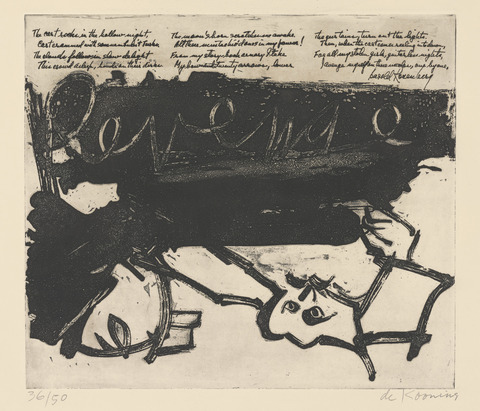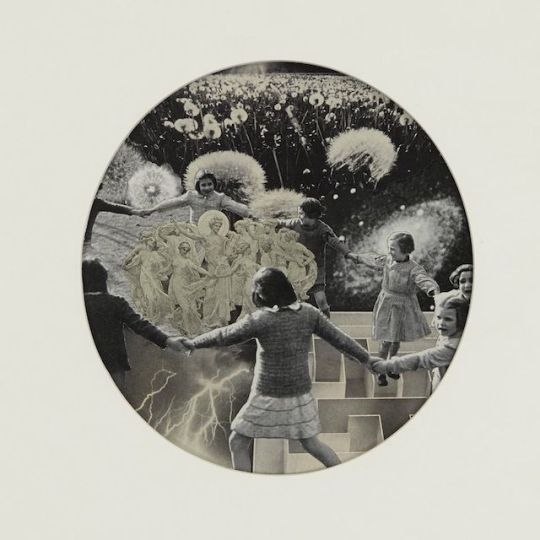Don't wanna be here? Send us removal request.
Text
21 Etchings and Poems
The complete 1960 limited edition was conceived by Peter Grippe in 1951 when he took over the directorship of Atelier 17, an internationally hailed graphic workshop.

Franz Kline with "Poem" by Frank O'Hara
This etching project, possibly the first of its kind in the United States, joined two creative disciplines – art and poetry. Poets and artists invited for this historic collaboration worked in the almost forgotten tradition of the Book of Kells and William Blake’s Illuminated poems. Each print closely integrates text and image, including a poem written in the hand of its author and imagery created through a wide range of innovative print techniques by an artist. For the poets who transferred their poems, in their own handwriting, onto the copper plate, this was an arduous, but exhilarating experience; a slip of tool meant beginning anew as they wrote backwards from a mirror image.
In 1954, the Atelier 17 was disbanded. Mr. Grippe, however, continued to work with the artists in his own studio. The etchings where finally completed in 1960, nearly ten years after its conception. 21 Etchings and Poems is not only a landmark of mid-20th century American print publishing, but is unique in its inclusion of diverse writers and artists from of the 1950s. Many of the poets and artists went on to become leaders in their art forms.
Collaborating Artists and Poets:
Pierre Alechinsky – Dotremont
Fred Becker – T. Weis
Ben-Zion – David Ignatow
Letterio Calapai – William Carlos Williams
Willem de Kooning – Harold Rosenberg
Peter Grippe – Dylan Thomas
Salvatore Grippi – Richard Wilbur
S.W. Hayter – Jacques-Henry Levesque
Franz Kline – Frank O’Hara
Jacques Lipchitz – Hans Sahl
Ezio Martinelli – Horace Gregory
Ben Nicholson – Sir Herbert Read
I. Rice Pereira – George Reavey
Helen Phillips – Andre Verdet
Andre` Racz – Thomas Merton
Kurt Roesch – Alastair Reid
Attilio Salemme – Morris Weisenthal
Louis Schanker – Harold Norse
Karl Schrag – David Lougee
Esteban Vincente – Peter Viereck
Adja Yunkers – Theodore Roethke






















Source
Source
4 notes
·
View notes
Photo
RE: Robert Duncan “Often I Am Permitted to Return to a Meadow”
It is only a dream of the grass blowing east against the source of the sun in an hour before the sun’s going down whose secret we see in a children’s game of ring a round of roses told.
"Ring a Ring o' Roses" or "Ring Around the Rosie" or "Ring a Ring o' Rosie" is a nursery rhyme or folksong and playground singing game. It first appeared in print in 1881, but it is reported that a version was already being sung to the current tune in the 1790s and similar rhymes are known from across Europe. It has a Roud Folk Song Index number of 7925. Urban legend says the song originally described the plague, specifically the Great Plague of London, or the Black Death, but folklorists reject this idea. // Wiki
Common American version:
Ring-a-round the rosie, A pocket full of posies, Ashes! Ashes! We all fall down.

// Jess, 1960


While teaching in Boulder, Colorado, Cunningham was inspired by children running and skipping on the street below his window. As he watched their playful games, Cunningham remembered, “They were having such a beautiful time. Field Dances came from that because I could see that they were running and skipping and to me it was dancing; but for them it wasn’t different.” Similar to the unstructured, carefree way the children played outside of Cunningham’s window, the dancers in Field Dances made their own choice of movements, leaving each performance different from the next. Each dancer was given a number of small events they could do together, and a few short dances to be done on their own. Robert Rauschenberg designed the colorful costumes, which were leotards with chiffon panels attached to the back for the women, and a sweatshirt for the men, over tights. Field Dances first premiered in 1963, with music by John Cage.
PREMIERE DATE - July 17, 1963 PREMIERE VENUE - University of California LOCATION - Los Angeles, CA MUSIC - John Cage Variations IV COSTUMES - Robert Rauschenberg DURATION - 12 minutes ORGINAL CAST - Shareen Blair, Carolyn Brown, Merce Cunningham, Viola Farber
Jess, “Emblems for Robert Duncan II, 4 (the ayre of the music carries)” (1989), collage, 4 ¼ x 5 5/8 in (image courtesy Tibor de Nagy Gallery, New York)
#Robert Duncan#dance#rosie#ring around the rosie#children#field#open field#Open Form#often i am permitted to return to a meadow#the opening of the field#jess#jess collins#1960#play#playground
2 notes
·
View notes
Quote
I can only begin a posteriori, by perceiving the world as vast and over-whelming; each moment stands under an enormous vertical and horizontal pressure of information, potent with ambiguity, meaning-full, unfixed, and certainly incomplete. What saves this from becoming a vast undifferentiated mass of data and situation is one’s ability to make distinctions. The open text is one which both acknowledges the vastness of the world and is formally differentiating. It is form that provides an opening.
Lyn Hejinian (via sketchesfromthealbum)
39 notes
·
View notes
Photo






Emblems for Robert Duncan
Jess Collins
14 collages by Jess. [24] p. Gray paper covers. 25 x 22.9 cm. Essay by John Yau.
Publisher: San Jose Museum of Art, 1990
5 notes
·
View notes
Photo

Viola Farber, dancer in "Summerspace", 1958. Black Mountain College (?). Choreographed by Merce Cunningham. Designed by Robert Rauschenberg. Music by Morton Feldman.
Summerspace 1958 PREMIERE DATE - August 17, 1958 PREMIERE VENUE - American Dance Festival, Connecticut College LOCATION - New London, CT MUSIC - Morton Feldman IXION DECOR - Robert Rauschenberg COSTUMES - Robert Rauschenberg DURATION - 15 minutes ORGINAL CAST - Carolyn Brown, Remy Charlip, Merce Cunningham, Viola Farber, Cynthia Stone, Marilyn Wood
This piece is indicative of Cunningham’s unique collaborative method, in which Feldman composed the score, Rauschenberg designed the décor, and Cunningham choreographed independently from each other. Together, the movement, music and décor give the effect of a balmy, summer day. Dressed in painted leotards, the dancers move about the stage in sudden bursts of speed and suspensions, zigzagging every which way, like flying creatures. The delicate music, at times sounds like bubbles of water rising to the surface, and at others, with a muffled rumble in the bass, like distant thunder.
#Summerspace#Merce Cunningham#1958#Robert Rauschenberg#Black Mountain College#dance#Morton Feldman#Viola Farber#field#space
5 notes
·
View notes
Photo

Robert Duncan (poem), Cy Twombly (woodblock print), and Nicholas Cernovitch (design and printing), Song of the Border-Guard, 1952, ink on paper, 20 x 26.5 inches. Black Mountain College Museum + Arts Center Collection. Gift of Nicholas Cernovitch.
Poem under cut
The man with his lion under the shed of wars sheds his belief as if he shed tears. The sound of words waits - a barbarian host at the borderline of sense. The enamord guards desert their posts harkening to the lion-smell of a poem that rings in their ears. -Dreams, a certain guard said were never designd so to re-arrange an empire. Along about six o'clock I take out my guitar and sing to a lion who sleeps like a line of poetry in the shed of wars. The man shedding his belief knows that the lion is not asleep, does not dream, is never asleep, is a wide-awake poem waiting like a lover for the disrobing of the guard; the beautil boundaries of the empire naked, rapt round in the smell of a lion. (The barbarians have passt over the significant phrase) -When I was asleep, a certain guard says, a man shed his clothes as if he shed tears and appeard as a lonely lion waiting for a song under the shed-roof of wars. I sang the song that he waited to hear, I, the Prize-Winner, the Poet Acclaimd. Dear, Dear, Dear, Dear, I sang, believe, believe, believe, believe. The shed of wars is splendid as the sky, houses our waiting like a pure song housing in its words the lion-smell of the beloved disrobed. I sang: believe, believe, believe. I the guard because of my guitar belive. I am the certain guard, certain of the Beloved, certain of the lion, certain of the Empire. I with my guitar. Dear, Dear, Dear, Dear, I sing. I, the Prize-Winner, the Poet on Guard. The borderlines of sense in the morning light are naked as a line of poetry in a war.
0 notes
Photo
...for Robert Duncan, “the cadence of the verse, and, in turn, the interpenetration of cadences in sequence is, for me, related to the dance of my physical body... Stress patterns are dancing feet; my ear and voice follow a deeper rhythm, the coming and going of a life/death tide back of the beat of the heart and the breath” (1984, ix). // Ground Work: Before the War


While teaching in Boulder, Colorado, Cunningham was inspired by children running and skipping on the street below his window. As he watched their playful games, Cunningham remembered, “They were having such a beautiful time. Field Dances came from that because I could see that they were running and skipping and to me it was dancing; but for them it wasn’t different.” Similar to the unstructured, carefree way the children played outside of Cunningham’s window, the dancers in Field Dances made their own choice of movements, leaving each performance different from the next. Each dancer was given a number of small events they could do together, and a few short dances to be done on their own. Robert Rauschenberg designed the colorful costumes, which were leotards with chiffon panels attached to the back for the women, and a sweatshirt for the men, over tights. Field Dances first premiered in 1963, with music by John Cage.
PREMIERE DATE - July 17, 1963 PREMIERE VENUE - University of California LOCATION - Los Angeles, CA MUSIC - John Cage Variations IV COSTUMES - Robert Rauschenberg DURATION - 12 minutes ORGINAL CAST - Shareen Blair, Carolyn Brown, Merce Cunningham, Viola Farber
Jess, “Emblems for Robert Duncan II, 4 (the ayre of the music carries)” (1989), collage, 4 ¼ x 5 5/8 in (image courtesy Tibor de Nagy Gallery, New York)
2 notes
·
View notes